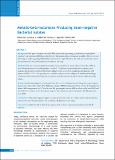Please use this identifier to cite or link to this item:
https://hdl.handle.net/20.500.14356/1942Full metadata record
| DC Field | Value | Language |
|---|---|---|
| dc.contributor.author | Mishra, S K | - |
| dc.contributor.author | Acharya, J | - |
| dc.contributor.author | Kattel, H P | - |
| dc.contributor.author | Koirala, J | - |
| dc.contributor.author | Rijal, B P | - |
| dc.contributor.author | Pokhrel, B M | - |
| dc.date.accessioned | 2023-06-02T05:57:52Z | - |
| dc.date.available | 2023-06-02T05:57:52Z | - |
| dc.date.issued | 2012 | - |
| dc.identifier.citation | MishraS. K., AcharyaJ., KattelH. P., KoiralaJ., RijalB. P., & pokhrelB. M. (2013). Metallo-beta-lactamase Producing Gram-negative Bacterial isolates. Journal of Nepal Health Research Council. https://doi.org/10.33314/jnhrc.v0i0.334 | en_US |
| dc.identifier.issn | Print ISSN: 1727-5482; Online ISSN: 1999-6217 | - |
| dc.identifier.uri | http://103.69.126.140:8080/handle/20.500.14356/1942 | - |
| dc.description | Original Article | en_US |
| dc.description.abstract | Abstract Background: The global emergence of metallo-β-lactamase (MBL) producing bacterial isolates causing lower respiratory tract infection (LRTI) has resulted in fewer therapeutic options in treatment modalities. However, to our knowledge no studies regarding MBLs had been done so far in Nepal. Therefore, this study was carried out to assess the current level of MBL producing bacterial isolates in our setup. Methods: This was a cross-sectional study conducted over a period of six months (June to November 2008) at Bacteriology laboratory of a teaching hospital. A total of 1120 specimens representing lower respiratory tract (sputum, endotracheal secretion and bronchial washing) were processed from outpatients and inpatients, with suspected LRTI, at TUTH. The specimens were collected and processed according to the standard methodology. Combination disk method and Double disk synergy test methods were used for the detection of MBL producing isolates. Results: Respiratory pathogens were recovered from 497 (44.4%) of suspected cases. Among these, gram-negative bacteria were observed in 448 (84.0%). Multidrug resistance (MDR) was found in 286 (53.7%) of the total bacterial isolates. MBL was present in 6 (1.3%) of the total 448 gram-negative isolates. MBL was detected by both DDST and CD methods in 3 isolates each of Pseudomonas aeruginosaand Acinetobacterspp. from inpatients. All MBL producers were MDR. Conclusions: MBL-producing gram negative bacteria were detected from LRTI isolates in this study and this data can be used as base-line information of this novel type of β-lactamase in our setup. Keywords: combination disk method; Gram-negative bacteria; lower respiratory tract infection; metallo-β-lactamase. | en_US |
| dc.language.iso | en | en_US |
| dc.publisher | Nepal Health Research Council | en_US |
| dc.relation.ispartofseries | Sep-Dec, 2012;334 | - |
| dc.subject | Combination disk method | en_US |
| dc.subject | Gram-negative bacteria | en_US |
| dc.subject | Lower respiratory tract infection | en_US |
| dc.subject | Metallo-β-lactamase | en_US |
| dc.title | Metallo-beta-lactamase Producing Gram-negative Bacterial isolates | en_US |
| dc.type | Journal Article | en_US |
| local.journal.category | Original Article | - |
| Appears in Collections: | Vol. 10 No. 3 Issue 22 Sep - Dec, 2012 | |
Files in This Item:
| File | Description | Size | Format | |
|---|---|---|---|---|
| 334-Article Text-333-1-10-20130823.pdf | Fulltext Download | 332.95 kB | Adobe PDF |  View/Open |
Items in DSpace are protected by copyright, with all rights reserved, unless otherwise indicated.
